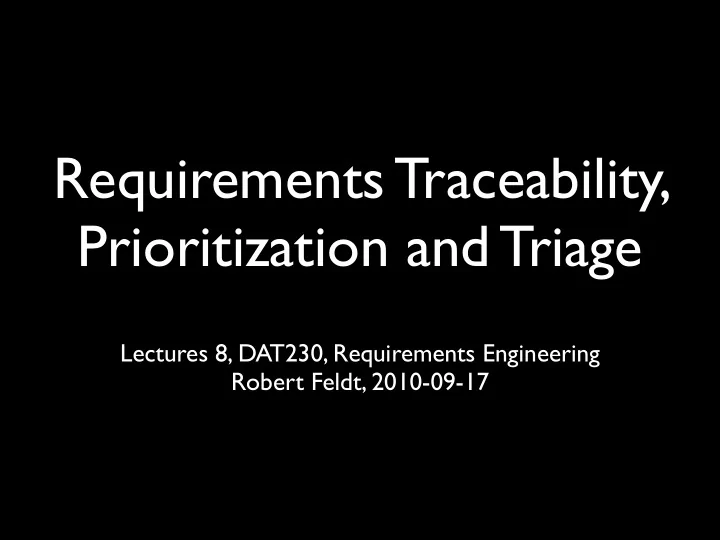

Requirements Traceability, Prioritization and Triage Lectures 8, DAT230, Requirements Engineering Robert Feldt, 2010-09-17
Notes about course • Individual assignment 2: • Only 128 of 150 submitted on time • A couple of lame excuses from the ones who missed • Don’t be late to exercises or lectures! • Better in the exercises this week! • Keep it up!
Notes about course • Group assignment: • Groups have been assigned (randomly): on course home page • 1st elicitation meeting have been booked for each group • If you must change YOU contact another group directly and switch • Course questions emailed to Ali Shahrokni • not Robert! • not All students!
Recap from last lecture
Recap • Req validation because reqs are hard to get right • Especially NatLang reqs • We should take responsibility for our own work; not leave defects for others => self-review, peer review... • Review is main validation technique • Prototypes of different sorts also used • “Creating” tests based on reqs is 3rd alternative • Elicitation, Specification and Validation support each other
Recap • Req validation because reqs are hard to get right • Especially NatLang reqs • We should take responsibility for our own work; not leave defects for others => self-review, peer review... • Review is main validation technique • Prototypes of different sorts also used • “Creating” tests based on reqs is 3rd alternative • Elicitation, Specification and Validation support each other
Traceability Requirements Traceability = “Ability to follow the ‘life’ of a requirement, in both forwards and backwards direction”
Traceability Requirements Traceability = “Ability to follow the ‘life’ of a requirement, in both forwards and backwards direction” backwards = origins, sources, reasons, versions, releases
Traceability Requirements Traceability = “Ability to follow the ‘life’ of a requirement, in both forwards and backwards direction” backwards = origins, sources, reasons, versions, releases forwards = to design, implementation, tests, use, refinement
Economic importance of Traceability? US Dept of Defense spends 4% of total IT budget on traceability issues [Ramesh2001]
Why do we need Traceability? • Certification - Have all reqs been implemented? • Testing - Where to test for this requirement? • Project tracking - What is status of project? • Maintenance - Where do I implement this a change? • Change impact analysis - What reqs and system parts are affected? • Reuse - What other requirements are affected?
Traceability: common examples • We need traceability to find: • dependencies between requirements • dependencies between versions of requirements • source of a requirement • where in the design a requirement is implemented • which requirements affect a particular part of design • tests for a certain requirement
Traceability dimensions example Text [Ramesh2001]
Traceability link categories Product Process [Ramesh2001]
Prioritization & Triage Requirements Prioritization = Req Triage = Req Negotiation = Req Selection = “Determine which candidate requirements go into the next release” Triage often more specific technique in MDRE though (of classifying reqs in three groups)
Prioritization techniques • 100 dollar test (Each distributes 100 points) • Yes-No vote (Sum of binary votes) • Five-way priority scheme (Sum of +2/+1/0/-1/-2) • Cost-Value approach (relative, pairwise) • Triage (MDRE approach)
Cost-Value approach
Cost-Value approach 1. Review reqs so they are complete and unambiguous 2. Customers/users/proxies compare pairwise for value 3. Engineers compare pairwise for cost 4. Calculate and plot relative cost and value for each req 5. Stakeholders discuss and select reqs based on diagram
Cost-Value approach: example
Triage (in MDRE)
Triage (in MDRE) New Reqs
Triage (in MDRE) New Reqs Triage
Triage (in MDRE) New Reqs Triage SHOULD MUST NOT
Triage (in MDRE) New Reqs Triage SHOULD MUST NOT Estimate resources
Triage (in MDRE) New Reqs Triage SHOULD MUST NOT Estimate resources Value, Cost, Risk
Triage (in MDRE) New Reqs Triage SHOULD MUST NOT Estimate resources Value, Cost, Risk Prioritize
Triage (in MDRE) New Reqs Triage SHOULD MUST NOT Estimate resources Value, Cost, Risk Prioritize Refine
Triage (in MDRE) New Reqs Triage SHOULD MUST NOT Estimate resources Value, Cost, Risk Prioritize Refine Select
Triage (in MDRE) New Reqs Iteratively & Triage Continuously! SHOULD MUST NOT Estimate resources Value, Cost, Risk Prioritize Refine Select
References • [Ramesh2001] B. Ramesh, M Jarke, “Toward reference models for requirements traceability”, IEEE Trans on SE, 2001
Recommend
More recommend